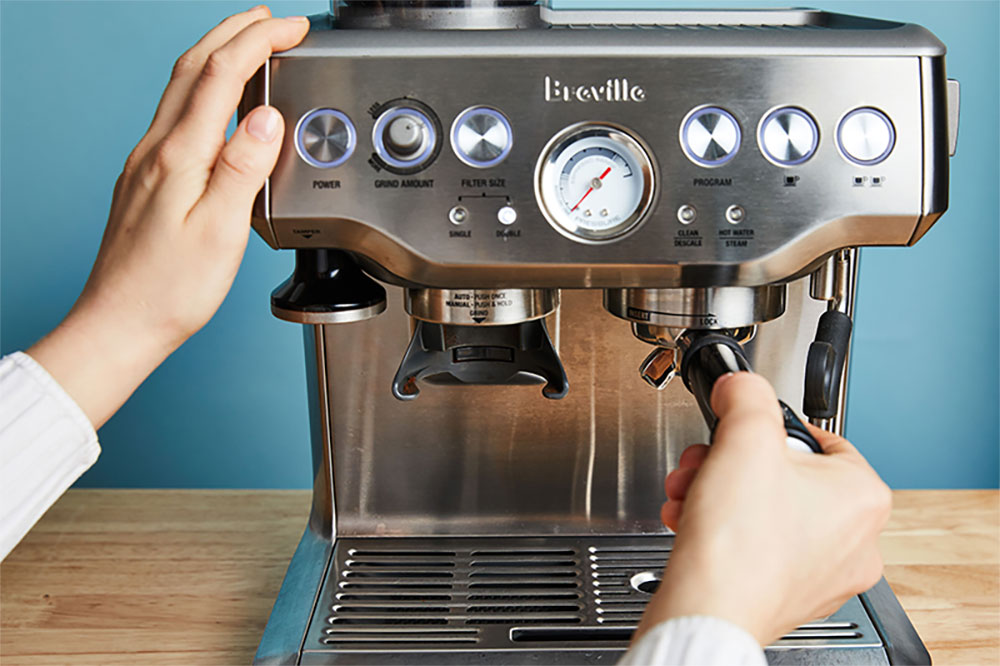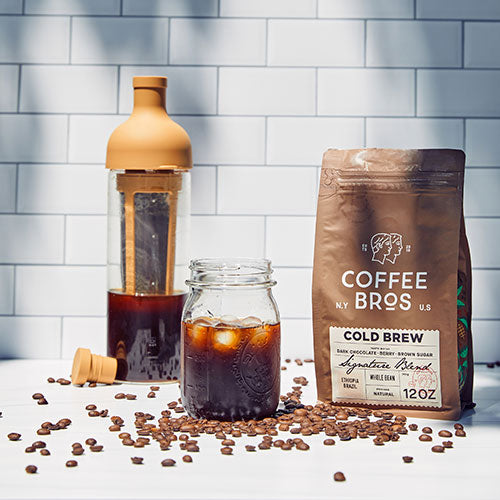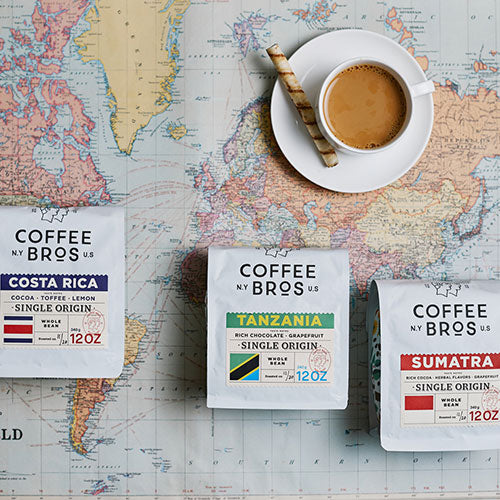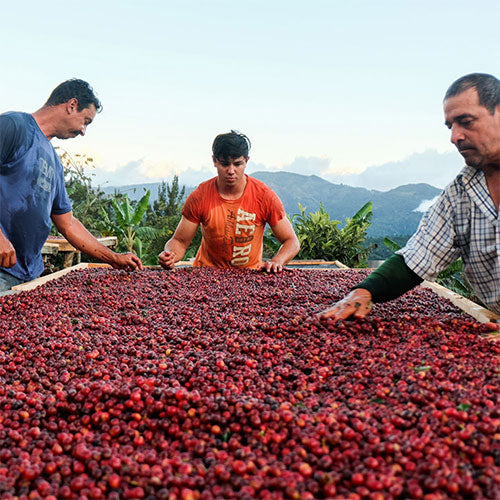The Best Coffee For Espresso Machines
Introduction
We firmly believe that any coffee roast level (light, medium, or dark) can be brewed any way, as long as you understand how time, temperature, and coffee-to-water ratios impact the final cup.
The above statement certainly holds true for espresso brewing, but with some caveats that we will unpack in our blog below.
This blog aims to help you find the best coffee for espresso, whether you are a straight espresso drinker or one who enjoys espresso with milk. We also point you in the right direction if you are brewing espresso on a super-automatic machine, as the choices with that type of espresso machine are more limited than others (more on that later).
Grab yourself an espresso (or wait until after you read this blog) and learn about the best coffee for espresso brewing!
Table of Contents
- What is espresso?
- What makes a good coffee for espresso?
- What are some things to watch out for when buying coffee for your espresso machine?
- What kind of ground coffee is needed for espresso machines?
- Should you use pre-gound coffee with your espresso machine?
- What is the best coffee milk-based espresso drinks like lattes and cappuccinos?
- What is the best coffee for straight espresso shots?
- What is the best coffee for americanos?
Coffee Subscription Deal
Subscribe to Coffee Bros. coffee for 25% off when using code "FTSUB25" at checkout
What is espresso
Espresso as a brewing method
Espresso is a coffee brewing method that involves forcing a small amount of near-boiling water through finely-ground coffee under pressure. The process involves finely grinding coffee into a portafilter basket, tamping it down, and securing it into an espresso machine. The machine then delivers water at an extremely stable temperature and applies 9 bars of pressure to force water through the coffee. The resulting beverage is a liquid espresso that contains soluble solids, soluble gases, and insoluble solids. Soluble solids give the espresso its taste and brew strength, soluble gases provide its aroma, and insoluble solids contribute to its body and mouthfeel, and serve as a barrier to perceived bitterness. A shot of espresso is composed of two layers - crema (light brown, on top) and liquid (dark brown, on the bottom).
Espresso as a coffee choice
All coffee is based on a preference from taste to what color you deem light, medium, or dark roasted coffee. We define espresso-roasted coffee not only by the color but how well that coffee pairs with the espresso brewing method. Espresso does not differ from coffee though consumers sometimes perceive it as different. The only difference between espresso and coffee is that specialty coffee roasters will go out of their way to source and roast coffee to pair well with espresso-based drinks (hence an espresso roast). If you read about our favorite Light Roasted Coffees, you will find that most of these coffees flavor gets lost within milk-based espresso drinks. Most roasters crafting coffee for espresso will push the “development” of that coffee to bring out more of its sugars to help it shine through any addition of milk.
What makes a good coffee for espresso
As mentioned in our intro, any coffee roast level can work for espresso if you are conscious of the brew time, temperature, and recipe. Coffees that are roasted lighter tend to work better at higher water-to-coffee ratios, such as a normale or lungo shot.
All of this changes when you add milk to your espresso beverage.
The spectrum of coffees that work well with an espresso roast shifts as you add milk to your drink. The more milk you add to your drink, the darker or more robust the coffee must be to cut through the milk. Light roasted coffees work exceptionally well as an espresso pulled at a higher ratio (more water) to help improve clarity and reduce acidity. As you start adding milk to lighter-roasted coffees, the milk begins to overpower any underlying taste from that coffee. Due to their development and caramelization, medium to darker roasted coffees can more easily cut through milk where your cappuccino tastes like coffee, not just a large glass of milk.
The key takeaway from the above is that depending on what type of espresso drinker you are will depend on what coffee roast level you should purchase.
Light roast coffee
- Lighter roasted coffees work better at higher water-to-coffee ratios like a “normale” or “lungo” shot.
- Lighter roasted coffee works great as an espresso, Americano, or smaller milk-based espresso drinks like a macchiato or cortado.
Medium roast coffee
- Medium roast coffee is versatile for espresso and works well across many ratios and drink types.
- The caramelization of a medium roast will allow it to easily cut through milk but stick to your classic drink sizes and recipes as suggested in our Espresso Drink Calculator.
Dark roast coffee
- Some find dark roast too bitter and robust for straight espresso shots, but dark coffee can still work well if brewed much cooler.
- Dark-roasted coffee pushes beyond the third stage of development and into carbonization, picking up those classic dark-roasted notes, deep chocolate, and smoky making it a great candidate for larger milk-based espresso drinks. If you like larger milk-based espresso drinks (maybe straying from the classic proportions), then a darker roasted coffee is the way to go.
Watch outs when buying coffee for your espresso machine
Temperature control
If you are in the market for an espresso machine or already have one, make sure you can monitor and alter the brewing temperature.
As mentioned earlier, different roast levels (light, medium, dark) do better at varying temperatures. Lighter-roasted coffees brew and taste best around 203 – 212 degrees Fahrenheit, while medium and darker-roasted coffees do best at or under 203 degrees Fahrenheit. Below is a table of recommended brew temperatures to experiment with different roast types.
The inability to alter brew temperature will limit what coffees work best on your machine, keep an eye out for this feature or understand the limitations of your machine.
| Roast Level | Recommended Brew Temp (Fahrenheit) |
| Light Roast | 199 - 205 |
| Medium Roast | 194 - 200 |
| Dark Roast | 188 - 194 |
Super-automatic espresso machines
If you own a super-automatic espresso machine, your choices for what coffees work best can be limited. We wrote an in-depth article on the topic you can read here, but we will break down what to watch out for if you own one of these machines.
Temperature limitations of super-automatic espresso machines
While super-automatic machines score high on their ease of use and design, they struggle to brew a wide range of coffees due to the lack of temperature control, grind size variability, and a complex internal system that is difficult to clean.
Research shows that most high-end super-automatic espresso machines brew far cooler than most coffee experts recommend, so darker-roasted coffees work best in these machines but watch out for coffee brewed too dark!
Dark oily coffee and super-automatic espresso machines
Dark oily coffee can wreak havoc on the internal system of super-automatic machines due to their oily exterior, which can build up over time, impacting future brews. If you watched the video under the section “How super-automatic espresso machines work,” you will see how the ground coffee passed into a brewing chamber and, once brewed, the puck is pushed out into a waste bin. When using an oily dark roast, the oils will create a film within the brewing chamber which is challenging to remove with the machine’s standard cleaning process. These oils, over time, can become rancid, which impacts subsequent brews in your machine.
Recommended Reading: Dark roast coffees for Super-Automatic Espresso Machines
What kind of ground coffee is needed for espresso machines?
Espresso machines require finely ground coffee to produce the proper pressure to craft an espresso beverage.
If a coffee is ground too coarse, the flow moving through the espresso puck (coffee grounds) will move too quickly, resulting in pressure loss. Traditional espresso is brewed at 9 bar of pressure and, depending on the machine, may hold the 9 bar of pressure throughout or have a slightly declining pressure profile like seen on lever machines. Suppose the integrity of the espresso puck is weak, either due to poor preparation or the ground coffee being too coarse. In that case, your machine will never hit the pressure to produce a rich cup of espresso with crema.
With all that said, using a coffee grinder that is graded for espresso is essential. Not every coffee grinder on the market can produce a grind fine enough for espresso.
Recommended Reading: Best espresso grinders for every skill-level and price point
Should you use pre-ground coffee with your espresso machine?
If you are looking to craft the perfect espresso each time, using pre-ground coffee will not produce the results you are looking for. Why is that, you ask?
- Peak freshness: The optimal freshness and aroma window for pre-ground coffee is significantly shorter than that of whole-bean coffee and deteriorates more rapidly. We find that the peak flavor of whole bean coffee can be upward of 30 days or more, while pre-ground coffee begins to lose its peak flavor after 7 – 10 days.
- Aroma: While it takes more time for whole-bean coffee to reach its peak flavor by allowing it to degas, the advantage is that it maintains its optimal taste and aroma for a longer duration, degrading much more slowly compared to pre-ground coffee. Whole-bean coffee can retain its aroma for 15 to 20 days longer than pre-ground coffee.
- Grind size: The optimal grind size needed for different coffee roast levels, light, medium, and dark, are all different regarding espresso. Further, depending on how you would like to brew your espresso in terms of recipe (ristretto, normale, or lungo) will determine your grind size. When buying pre-ground coffee, you expect the roaster to account for roast levels and intended brew recipe, which will unfortunately never be the case.
- Grind size adjustments: As coffee ages, even a few days, the grind size needed to hit optimal brew ratios, or your intended recipe will also need to change. This is why they make coffee grinders with stepped or stepless changes. Grinders with an unlimited range allow you to constantly make minor adjustments to the grind size to compensate for the aging and degassing of the coffee. Coffee that comes preground is stuck at that one grind size, and no further adjustments can be made.
The best coffee for milk-based espresso drinks
You’ll find that medium to darker-roasted coffees work best for milk-based espresso drinks due to their deeper development during the roasting process, bringing out caramelization. The increased caramelization helps cut through the milk and maintain the rich coffee taste one would expect. Lighter-roasted coffees lack much of the caramelization in medium and darker-roasted coffees, so they struggle to shine through when using them for milk-based espresso drinks.
We recommend sticking with medium to darker coffees for espresso with milk (even straight espresso) and exploring lighter roasted coffees as espresso with larger water-to-coffee ratios (think lungo or an Americano).
What is the best coffee for espresso shots
What is the best coffee for Americanos
The Americano is quite a forgiving drink due to the addition of water. Those who enjoy light-roasted coffees brewed via drip might find the Americano a suitable alternative to a straight espresso shot. Light-roasted coffees can be tricky as a straight espresso shot. Adding water to the Americano adds clarity and reduces the acidic punch that light-roasted espresso can sometimes have.
Other than light-roasted coffees, both medium and dark-roasted coffees work well as an Americano. Darker-roasted coffees for an Americano will give you more of that “regular coffee” flavor and feel. Since adding water to the espresso shot will dilute the drink, dark roasted coffees will still carry deeper notes of chocolate and nuttiness, which may be what you want with your Americano.




